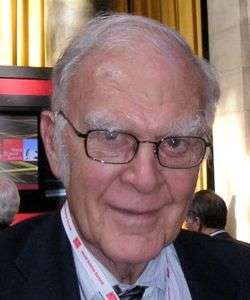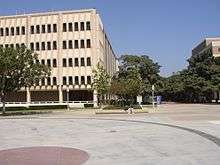F. Sherwood Rowland
| Frank Sherwood Rowland | |
|---|---|
 Rowland at the inaugural World Science Summit, May 2008 | |
| Born |
June 28, 1927 Delaware, Ohio |
| Died |
March 10, 2012 (aged 84) Newport Beach, California |
| Nationality | United States |
| Fields | Chemistry |
| Institutions | University of California, Irvine |
| Alma mater |
|
| Thesis | The epithermal reactions of recoil atoms (1952) |
| Doctoral advisor | Willard Libby |
| Known for | Ozone depletion research |
| Notable awards |
|
Frank Sherwood "Sherry"[4] Rowland (June 28, 1927 – March 10, 2012) was an American Nobel laureate and a professor of chemistry at the University of California, Irvine. His research was on atmospheric chemistry and chemical kinetics. His best-known work was the discovery that chlorofluorocarbons contribute to ozone depletion.[5][6]
Education and early life
Born in Delaware, Ohio, Rowland received a majority of his education in public schools and, due to accelerated promotion was able to graduate high school several weeks before his 16th birthday.[7] In the summers during his high school career, Frank was entrusted to run the local weather service station. This was Rowland's first exposure to systematic experimentation and data collection. After entering Ohio Wesleyan University, Rowland was about to graduate shortly before his 18th birthday. Instead, he was enlisted to the Navy to train radar operators. Rowland was discharged after 14 months as a non commissioned officer. After entering the University of Chicago, Rowland was assigned Willard F. Libby as a mentor and began to study radiochemistry. Rowland's thesis was about the chemical state of cyclotron-produced radioactive bromine atoms. Rowland received his B.A. from Ohio Wesleyan University in 1948. He then earned his M.S. in 1951 and his Ph.D. in 1952, both from the University of Chicago.[8]
Career and research
Rowland held academic posts at Princeton University (1952–56) and at the University of Kansas (1956–64) before becoming a professor of chemistry at the University of California, Irvine, in 1964. At Irvine in the early 1970s he began working with Mario J. Molina. Rowland was elected to the National Academy of Sciences in 1978 and served as a president of American Association for the Advancement of Science (AAAS) in 1993. His best-known work was the discovery that chlorofluorocarbons contribute to ozone depletion. Rowland theorized that man made organic compound gases combine with solar radiation and decompose in the stratosphere, releasing atoms of chlorine and chlorine monoxide that are individually able to destroy large numbers of ozone molecules. It was obvious that Frank had a good idea of what was occurring at higher altitudes when he stated "...I knew that such a molecule could not remain inert in the atmosphere forever, if only because solar photochemistry at high altitudes would break it down".[9] Rowland's research, first published in Nature magazine in 1974, initiated a scientific investigation of the problem. In 1978, a first ban on CFC-based aerosols in spray cans was issued in the United States. The actual production did however not stop and was soon on the old levels. It took till the 1980s to allow for a global regulation policy.
Rowland performed many measurements of the atmosphere. One experiment included collecting air samples at various cities and locations around the globe to determine CCl3F North-South mixing. By measuring the concentrations at different latitudes, Rowland was able to see that CCl3F was mixing between hemispheres quite rapidly. The same measurement was repeated 8 years later and the results showed a steady increase in CCl3F concentrations. Rowland's work also showed how the density of the ozone layer varied by season increasing in November and decreasing until April where it levels out for the summer only to increase in November. Data gained throughout successive years showed that although the pattern was consistent, the overall ozone levels were dropping. Rowland and his colleagues interacted both with the public and the political side and suggested various solutions, which allowd to step wise reduce the CFC impact. CFC emissions were regulated first within Canada, the United States, Sweden and Norway. In the 1980s, the Vienna Agreement and the Montreal Protocol allowed for global regulation.[10]
Awards and honors

Rowland won numerous awards for his work:
- Tolman Medal, 1976
- Tyler Prize for Environmental Achievement, 1983
- Japan Prize, 1989
- Peter Debye Award, 1993
- Albert Einstein World Award of Science, 1994[11]
- Roger Revelle Medal, 1994
- Nobel Prize in Chemistry, 1995
- In 1998, the UC Irvine physical sciences building was named after Rowland. A bust of Rowland is visible in the lobby.[12]
- Elected a Foreign Member of the Royal Society (ForMeRS) in 2004[1][2]
- Mount Rowland in Antarctica was named after him in 2007[13]
Personal life
Frank Rowland is the father of art historian Ingrid Rowland, and Jeff Rowland. He has two granddaughters. After suffering from a short bout of ill health, Rowland died on March 10, 2012, of complications from Parkinson's disease.[14] Upon hearing the news, renowned chemist and good friend Mario J. Molina stated: "Sherry was a prime influence throughout my career and had inspired me and many others to walk in the shadow of his greatness".[8]
References
- 1 2 "Fellows of the Royal Society". London: Royal Society. Archived from the original on March 16, 2015.
- 1 2 "Fellowship of the Royal Society 1660–2015". Royal Society. Archived from the original on July 15, 2015.
- ↑ Laureates of the Japan Prize. japanprize.jp
- ↑ Roan, Shari (2012-03-12). "F. Sherwood Rowland dies at 84; UC Irvine professor won Nobel Prize". Los Angeles Times. ISSN 0458-3035. Retrieved 2016-09-14.
- ↑ Prather, M. J.; Blake, D. R. (2012). "F. Sherwood Rowland (1927–2012)". Nature. 484 (7393): 168. doi:10.1038/484168a. PMID 22498618.
- ↑ Molina, M. J.; Rowland, F. S. (1974). "Stratospheric sink for chlorofluoromethanes: Chlorine atom-catalysed destruction of ozone". Nature. 249 (5460): 810. doi:10.1038/249810a0.
- ↑ Nobel Lectures in Chemistry (1991–1995). Singapore: World Scientific Publishing. 1997. p. 296. ISBN 981-02-2679-9.
- 1 2 F. Sherwood Rowland – Biographical. nobelprize.org
- ↑ Nobel Lectures in Chemistry (1991–1995). Singapore: World Scientific Publishing. 1997. p. 296. ISBN 981-02-2679-9.
- ↑ Nobel Lectures in Chemistry (1991–1995). Singapore: World Scientific Publishing. 1997. p. 296. ISBN 981-02-2679-9.
- ↑ "Albert Einstein World Award of Science 1994". Retrieved August 13, 2013.
- ↑ Meier, James; Canalis, John (1998-10-09). "University Dedicates Building to Nobelist". Los Angeles Times. ISSN 0458-3035. Retrieved 2016-09-14.
- ↑ "Mount Rowland". Geographic Names Information System. United States Geological Survey. Retrieved February 10, 2016.
- ↑ Barringer, Felicity (March 12, 2012). "F. Sherwood Rowland, 84, Dies; Raised Alarm Over Aerosols". The New York Times.
External links
| Wikimedia Commons has media related to Frank Sherwood Rowland. |
| Wikiquote has quotations related to: Frank Sherwood Rowland |
Bibliography
Technical Reports:
- "Radiochemistry Research: Progress Report, October 1, 1974 to September 30, 1975", University of California, Irvine, United States Department of Energy (through predecessor agency the Atomic Energy Commission), (1975).
- "Research in Chemical Kinetics: Progress Report, January 1, 1978 to September 30, 1978", University of California, Irvine, United States Department of Energy, (1978).
- "Research in Chemical Kinetics. Annual Report, 1993", University of California, Irvine, United States Department of Energy, (1993).
- "Research in Chemical Kinetics. Annual Report, 1994", University of California, Irvine, United States Department of Energy, (June 1, 1994).
Archival collections
- F. Sherwood Rowland Papers. Special Collections and Archives, The UC Irvine Libraries, Irvine, California.
Other
- CFCs, Ozone Depletion and Global Warming Freeview video interview with F.Sherwood Rowland provided by the Vega Science Trust.
- Nobel Prize Biography
- Biography and Bibliographic Resources, from the Office of Scientific and Technical Information, United States Department of Energy
- UCI Nobel winner F. Sherwood 'Sherry' Rowland dies at 84 Orange County
- Ozone layer scientist who 'saved the world' dies Guardian
- Obituary in The Independent by Marcus Williamson
- Andersen, Stephen O.; Conzalez, Marco (2012). "Frank Sherwood Rowland". Physics Today. 65 (10). p. 70. doi:10.1063/PT.3.1759.
